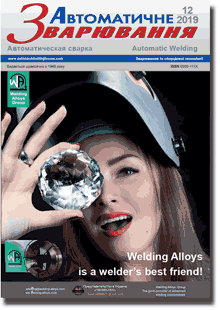| 2019 №12 (07) |
DOI of Article 10.15407/as2019.12.01 |
2019 №12 (02) |

"Avtomatychne Zvaryuvannya" (Automatic Welding), #12, 2019, pp.4-11
Influence of thermal cycle of surfacing on mechanical properties and resistance to brittle fracture of haz metal of rail wheel steel M76
V.D. Poznyakov, O.A. Gaivoronsky, V.A. Kostin, O.M. Berdnikova, S.V. Shmigelsky
11 Kazymyr Malevich Str., 03150, Kyiv, Ukraine. E-mail: office@paton.kyiv.ua
Increasing the life of railway wheels is an urgent task. The solution to this problem is associated with the optimization of the structural state of metal of the railway wheels. In the work the influence of cooling rate during melting on mechanical properties, resistance to brittle fracture and structural changes of HAZ of wheel steel with carbonitride strengthening with a carbon content of 0.63% were investigated. It is shown that in the course of surfacing a hardening bainite-martensitic structure is formed, the volume fraction of the structural components in which is determined by the cooling rate. The hardened HAZ metal of wheel steel with carbonitride strengthening has a high strength and a low ductility and has a high tendency to brittle fracture. 12 Ref., 2 Tabl., 11 Fig.
Keywords: arc surfacing, carbonitride strengthening, heat-affected-zone, thermal cycle, brittle fracture
Received: 10.10.2019
Published: 17.12.2019.
References
1. Uzlov, I.G. (2003) Advanced processes of manufacturing and quality of railway wheels. Stal, 5, 69-72 [in Russian].2. Railway wheels and tyres KLW (Interpipe NTZ Ukraine). www.interpipe.biz [in Russian].
3. Uzlov, I.G., Babachenko, A.I., Dementieva, Zh.A. (2005) Influence of steel microalloying on fracture toughness of railway wheels. Metallurgiya i Gornorudnaya Promyshlennost, 5, 46-47 [in Russian].
4. Babachenko, A.I., Litvinenko, P.L., Knysh, A.V. et al. (2011) Improvement of chemical composition of steel for railway wheels ensuring the increase of their resistance to defect formation on roll surface. In: Fundament. i Prikl. Problemy Chyorn. Metallurgii, Transact. of IFM, NANU, 23, 226-233 [in Russian].
5. Ivanov, B.S., Filipov, G.A., Demin, K.Yu. et al. (2007) Modification of wheel steel by nitrogen. Stal, 9, 22-25 [in Russian]. https://doi.org/10.3103/S0967091207090112
6. Sarzhevsky, V.A., Sazonov, V.Ya. (1981) Installation for simulation of welding thermal cycles on the base of MSR-75 machine. Avtomatich. Svarka, 5, 69-70 [in Russian].
7. Gajvoronsky, A.A., Poznyakov, V.D., Markashova, L.I. et al. (2016) Brittle fracture resistance of HAZ metal in arc-welded joints of high-strength steels with carbon content of 0.55-0.65 %. The Paton Welding J., 9, 2-8. https://doi.org/10.15407/tpwj2016.09.01
8. (1972) New methods for evaluation of brittle fracture resistance of metals. Ed. by Yu.N. Robotnov. Moscow, Mir [in Russian].
9. (1985) GOST 25.506-85: Methods of mechanical testing of metals. Determination of fracture toughness characteristics under the static loading. Moscow, Izd-vo standartov [in Russian].
10. Gajvoronsky, A.A. (2014) Resistance to cold crack formation of HAZ metal of welded joint of high-strength carbon steels. The Paton Welding J., 2, 2-11. https://doi.org/10.15407/tpwj2014.02.01
11. Cherepin, V.T. (1968) Experimental technique in physical metal science. Kiev, Tekhnika [in Russian].
12. Vasiliev, V.G., Sarzhevsky, V.A., Kornienko, T.A., Gajvoronsky, A.A. (1997) Attachment to dilatometer for examination of phase transformations at low temperatures. Avtomatich. Svarka, 5, 55-57 [in Russian].
